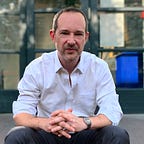The Maker’s Chronicle
Welcome all to the inaugural post of Coda Story’s new Maker’s Chronicle: a blog about the process and inspiration behind the visual work we do here at Coda Story. As Coda’s Creative Director I lead the development and production of our visual storytelling — from documentary films, VR, and animation, to photography, web interactive, and projects using live performance and physical space. I work closely with Coda’s editors and our visual media team to advance Coda’s mission of reframing how audiences engage stories about global crises.
The goal here is twofold: to showcase the inspiration behind our work and to ask ourselves — publicly and candidly — how our storytelling can be stronger. I often refer to the work we do as “design-forward journalism,” a term meant to signify an approach that is open to inspiration from beyond the non-fiction genre, and that places the user experience at the core of our design methodology.
Journalists around the globe publish work every day that has real and immediate consequences in our lives, but too often these stories don’t connect with the audiences they deserve. This for me is the fundamental design challenge of journalistic storytelling today and a question that informs every aspect of the work I do here at Coda.
To help set the tone of future posts, I’ll start by sharing a few examples of work that I’ve been thinking about recently in my practice:
- The Big Short (2015)
The Big Short is a scripted feature film based on Michael Lewis’ book about the 2007 US financial crisis. While very few people I know would be comfortable describing this film as journalism, it has nevertheless succeeded where many have failed in demystifying the crisis in ways that are both interesting and accessible to a broad audience. Is this level of cinematic, character-driven storytelling possible with documentary content? For the right kind of stories, yes (check out Coda’s doc series A Ukrainian Love Story). But only if you believe in the possibility, and aim for it from the very beginning.
2. Territory (2017)
Music videos aren’t discussed very often in the world of non-fiction media production, but they should be. Filmed in a documentary style, this piece by The Blaze features an oblique and immersive narrative about a young man’s return home from overseas. We see conflict between belonging and alienation, between masculinity and vulnerability, set against a hypnotic backdrop of male, youth culture in modern-day Algiers. Though Territory is not a documentary, it very well could have been, and this begs the question I should have asked years ago: if we know that music videos can deliver visceral storytelling with popular reach (Beyonce’s Single Ladies has over one billion views), why aren’t we making documentaries in the form of music videos? The genre holds tremendous potential for non-fiction storytelling: short pieces that prioritize style and cinematography, appeal to young audiences, transcend language barriers, and subvert the tired stereotype that documentary films are formally unimaginative. I’m working on prototyping something like this now at Coda.
3. Misunderstood (2013)
Friends and colleagues know my fondness for television commercials — the best examples have impeccable attention to style and narrative economy, and are phenomenally successful at inspiring an emotional connection to an idea. This piece for Apple was filmed in a very deliberate observational style, and therein lies its strength. Would it have worked as well with studio lighting, dolly shots, and A-list actors? Of course not, and the makers’ decision to use a non-fiction aesthetic is a potent reminder that documentaries can take us places that even the strongest scripted content cannot.
This piece mixes scripted storytelling with documentary technique, but this model could also be inverted for our purposes: documentary stories that use camera and editing methods more commonly seen in scripted feature films, advertising, and dramatic episodic television. We’re seeing more of this kind of content now, and this could finally be the fuel we’ve needed to push the documentary genre into a new era.
Stay tuned to this space for more on the process and inspiration behind storytelling at Coda.
